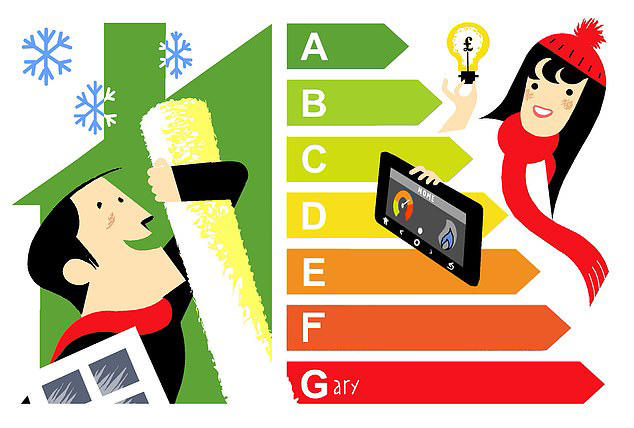- Energy performance certificates were largely ignored by home buyers for years
- But now bills are higher, a home with a good score can save serious cash
- Here are eight ways to boost your property’s energy efficiency
Temperatures and house prices have both seen falls recently — and improved energy efficiency at home might just help us cope with both of them.
That’s because there’s a new-found interest from owners, sellers and buyers in every home’s Energy Performance Certificate.
An EPC indicates the home’s energy efficiency from A (very good) to G (poor) and you can check yours on the Government website.
For years after the EPC was first introduced in 2007 it was largely ignored by buyers, but now interest is soaring thanks to rocketing energy bills.
The latest price cap from energy regulator OFGEM — applying to 29million homes in England, Scotland and Wales — is an eye-watering £1,923 per year. This is less than last winter, but higher than two years ago when the cap was £1,277.
As a result, buyers are paying attention to EPCs and Propertymark, the estate agents’ trade body, says now only 15 per cent of buyers fail to ask questions about a home’s energy efficiency.
Inevitably the most modern homes are likely to be more energy efficient with 85 per cent awarded an A or B EPC versus just 4 per cent for older properties, according to a study by the Home Builders Federation.
But there’s now a drive for owners of older properties — especially those wanting to sell in the near future — to retrofit energy efficient heating, lighting and insulation.
So if you’re taking the plunge and putting your home on the market soon, what improvements can boost your EPC and the asking price and saleability?
There are plenty of ideas from organisations such as the Energy Saving Trust, Uswitch, This is Money and the Government’s own campaign.
How to boost your EPC rating
Wall insulation
About a third of all heat lost in a badly insulated home is through walls, so if you have cavity walls fill them with insulation material.
If you have solid walls, insulte inside or outside. The Government’s Great British Insulation Scheme offers grants for the lowest income households.
Floors
Insulating under the ground floor floorboards is highly effective in any size property, while sealing between floorboards and filling the gaps between floors and skirting boards keep draughts at bay — and can be done with minimal DIY skills.
Lofts
The Energy Saving Trust says even homes with some loft insulation rarely have enough. Aim for 270mm of insulation.
Low-energy lighting
If an average house replaced traditional and halogen light-bulbs with energy efficiency LED lights, this would cost about £90.
Hot water tank
Hot water cylinder jackets are cheap and easy to fit. A British Standard one should be 80mm thick.
Get a smart meter
Supplied by your energy provider, this gives near real-time information on energy usage and cuts the need for irritating estimated bills, allowing better budgeting.
Buy a condensing boiler
An A-rated boiler with thermostatic radiator valves costs £5,000 but it will attract potential buyers and boosts your EPC.
Install double glazing
Low E PVC are cheapest and hardwood frames cost more.



